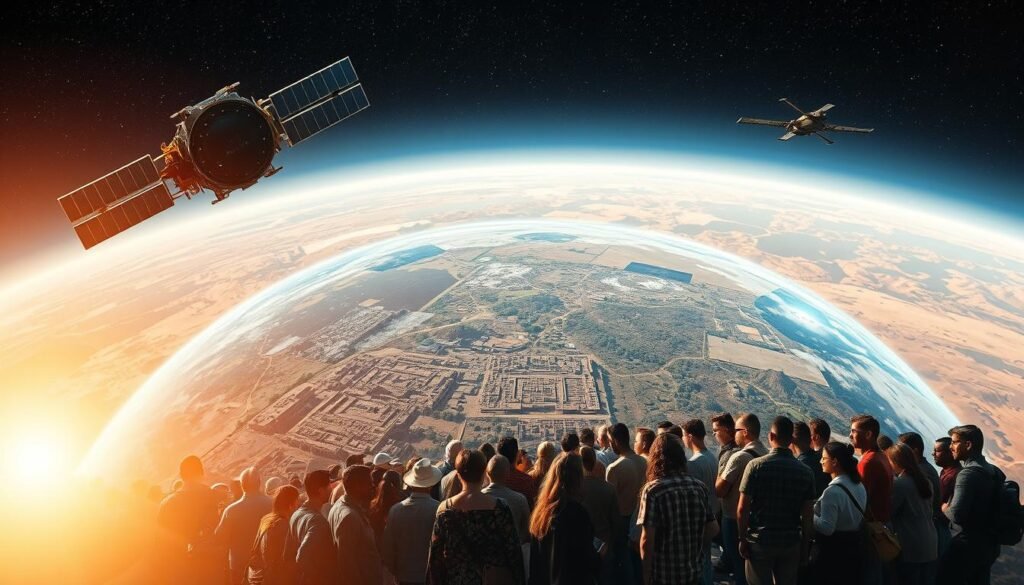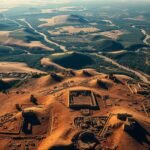Imagine exploring ancient civilizations from your computer. Satellite imagery now lets you do just that. This technology has revolutionized how we uncover hidden history.
Remote sensing archaeology uses space technology to see beneath the earth’s surface. Researchers can study massive landscapes without digging. This protects precious sites from damage.
You can now participate in discoveries from home. Amateur archaeologists help professionals analyze data. This collaboration leads to incredible finds.
Different sensors work together to create detailed maps. They reveal buried structures and ancient features. This technology represents a major breakthrough for the field.
Key Takeaways
- Satellite technology reveals hidden archaeological sites without excavation
- Researchers can study massive areas quickly using remote sensing
- This technology helps protect vulnerable sites from development and looting
- Different satellite sensors work together to create comprehensive landscape maps
- Amateur archaeologists can now participate in discoveries from home
- Satellite data has led to major discoveries that rewrite history books
- The technology represents one of archaeology’s most important advances
How Satellite Imaging is Revolutionizing Your Understanding of History
Military reconnaissance technology has unexpectedly become archaeology’s greatest asset. Space-based observation platforms now reveal hidden human history that remained invisible for centuries.
This technology transforms how you see ancient civilizations. Instead of isolated dig sites, you can now study entire regions spanning hundreds of kilometers. The true scale of past societies becomes dramatically clear.
Different sensing systems work together to create comprehensive landscape maps. Optical imagery shows visible clues while infrared detection reveals buried features. Radar penetration sees through sand and vegetation.
You gain insight into ancient agricultural patterns and transportation networks. Settlement expansion becomes visible across time. This big earth data requires sophisticated processing but yields incredible insights.
Temporal resolution allows researchers to study changes over decades. You can watch urban sprawl threaten vulnerable sites. This information helps protect precious heritage from development.
The democratizing effect makes discovery accessible worldwide. Professionals and amateurs now collaborate on analysis. This interdisciplinary approach combines geography, earth science, and traditional methods.
Space-based observation has become as valuable as carbon dating for modern research. The paradigm shift in methodology opens new pathways for understanding our past.
You can appreciate how remote sensing archaeology reveals what ground surveys miss. Entire civilizations once underestimated now show their true complexity through orbital perspective.
The Core Impact of Satellite Imaging on Archaeological Discoveries
Picture yourself scanning vast landscapes from orbit. You spot subtle patterns invisible from ground level. This perspective revolutionizes how we find hidden history.
Dr. Athos Agapiou at Cyprus University of Technology leads this change. His team develops smart algorithms that process massive earth observation data. These methods identify buried remains without disturbing the soil.
You can now explore large areas quickly using space technology. This non-destructive approach protects delicate heritage sites. Researchers study entire regions instead of small dig locations.
Buried structures create unique signatures in their environment. They affect vegetation growth, soil moisture, and surface temperature. Specialists detect these changes through multi-sensor analysis.
Different landscapes present unique challenges for detection. Non-homogeneous areas with mixed vegetation require advanced tools. Automated systems improve accuracy in identifying archaeological features.
Urban expansion threatens countless cultural sites worldwide. Satellite data helps track development over decades. This information supports heritage protection efforts.
“Space technology gives us unprecedented tools for cultural management. We can protect what we haven’t even discovered yet.”
Looting remains a serious problem for archaeology. Orbital monitoring helps combat illegal digging and artifact trading. Regular imaging creates valuable records for vulnerable locations.
Multiple sensing systems work together beautifully. Each sensor provides different types of information. Combined data creates comprehensive understanding of buried landscapes.
This technology represents archaeology’s digital transformation. You participate in discoveries that rewrite history books. The field will never look the same again.
A Brief History of Looking Down to Look Back
You might be surprised to learn that archaeologists first looked down from above long before satellites existed. Early researchers climbed hills and used hot air balloons to gain better views. They noticed that crops grew differently over buried ruins, creating visible patterns from above.
These crop marks revealed hidden structures without any digging. Aerial photography became archaeology’s first remote sensing tool. This method helped identify numerous sites across large areas.
Everything changed when NASA entered the picture. Tom Sever pioneered space archaeology at Stennis Space Center in 1981. His team used advanced sensors like TIMS and ATLAS to map ancient landscapes.
Their work at Chaco Canyon revealed astonishing discoveries. They found ancient roadways thirty feet wide running perfectly straight. This proved that satellite data could uncover what ground surveys missed.
The Landsat program launched in 1972 revolutionized everything. It provided continuous earth imagery every sixteen days. This created an unprecedented archive of comparable data.
Resolution improvements dramatically enhanced capabilities. Early 79-meter resolution sharpened to 15 meters over forty-five years. Each improvement brought new archaeological features into focus.
Four resolution types became crucial for discovery. Spatial resolution determines how small an object you can see. Spectral resolution measures different wavelength detection.
Radiometric resolution improved from 6-bit to 12-bit data. This refinement brought incredible detail to image analysis. Temporal resolution allows monitoring changes over time.
Infrared data proved particularly valuable for archaeological research. It detects moisture differences in vegetation and soil. These variations often indicate buried structures.
What began as military and environmental technology found amazing applications. Space tools now help uncover human history in ways nobody imagined. This journey from balloons to satellites transformed entire field.
You can appreciate how each technological advance built upon the last. Early aerial photography led to sophisticated satellite remote sensing. Today’s researchers benefit from decades of continuous innovation.
How Satellite Prospection Works: The Science Behind the Discovery
Modern archaeology uses six distinct sensing technologies to uncover lost civilizations. Each method captures different information about buried structures and landscapes. Together, they create a comprehensive picture of ancient human activity.

These tools work by measuring how materials interact with various light wavelengths. Buried remains create subtle changes in vegetation, soil, and temperature. Specialized detectors onboard satellites identify these unique signatures.
Optical Remote Sensing: Seeing the Visible Clues
Optical sensors capture visible light between 0.4-0.7 micrometers. They provide sub-meter resolution from platforms like WorldView-4 and Pleiades. You get detailed images showing surface features and patterns.
This technology remains the backbone of earth observation despite limitations. It requires daylight and clear weather conditions. Yet it delivers the sharpest visual details for analysis.
Near-Infrared (NIR) Sensing: Seeing Beyond Human Sight
NIR detectors operate between 0.7-1.4 micrometers wavelength range. They excel at identifying vegetation health above buried structures. The distinctive “red edge” in spectral profiles reveals stress patterns.
This method penetrates thin clouds better than visible light sensors. It helps researchers identify potential sites through plant vitality changes. You can spot archaeological features through their effect on growing plants.
Short-Wave Infrared (SWIR) Sensing: Mapping Minerals and Moisture
SWIR technology uses 1.4-3.0 micrometer wavelengths for detection. It senses moisture content and mineral properties in soil and structures. This capability helps identify ancient settlement sites and agricultural areas.
The sensor penetrates haze and smoke effectively. It provides clear data even in challenging atmospheric conditions. You get reliable information about subsurface composition.
Thermal Infrared (TIR) Sensing: Detecting Heat Signatures of the Past
TIR detectors measure heat energy between 3.0-14.0 micrometers. They identify temperature differences smaller than 0.1°C day and night. Buried features heat and cool at different rates than surrounding soil.
This technology works around the clock regardless of sunlight. It reveals subsurface structures through differential thermal patterns. You can detect ancient foundations and pathways invisible to other sensors.
LiDAR: Stripping Away Vegetation to Reveal Landscapes
LiDAR uses laser pulses to create high-precision 3D models of terrain. It effectively removes forest canopy to reveal ground surfaces below. You see hidden landscapes with incredible detail and accuracy.
This method revolutionized jungle archaeology particularly. It exposes ancient modifications to landforms beneath dense vegetation. Researchers can map entire cities hidden for centuries.
Radar: Peering Through Clouds and Sand
Radar systems penetrate vegetation, cloud cover, and even sand layers. They expose ancient landforms modified by human activity. You can explore regions with persistent cloud cover or desert environments.
This technology reveals features other sensors cannot detect. It works in all weather conditions and provides unique perspective. Combined with other methods, it creates complete understanding of sites.
Archaeologists use these technologies together for best results. Each sensor provides different pieces of the puzzle. Synergistic analysis yields comprehensive understanding of buried landscapes.
Resolution types determine what features you can detect. Spatial resolution defines how small an object you can identify. Spectral resolution measures wavelength detection capabilities.
Radiometric resolution improved dramatically over decades. Today’s systems capture incredible detail for accurate analysis. Temporal resolution allows monitoring changes over time.
These advanced tools reveal features invisible to naked eye. They transform how we study past human civilizations. You benefit from decades of technological innovation in space exploration.
From Theory to Trowel: Major Archaeological Breakthroughs
Groundbreaking finds across multiple continents prove satellite archaeology’s value. These discoveries rewrite history books and transform our understanding of ancient societies.
Egyptian research revealed astonishing numbers through space technology. Seventeen unknown pyramids emerged from desert sands without excavation. Researchers also identified 3,100 settlements and 1,000 tombs that remained hidden for centuries.
Maya lowlands surveys completely changed population theories. LiDAR technology showed extensive landscape modifications supporting dense populations. These findings overturned previous assumptions about their environmental impact.
Amazon basin studies revealed surprising agricultural systems. Remote sensing identified ancient farming networks in areas considered pristine wilderness. This discovery changed perceptions about pre-Columbian land use.
Angkor Wat’s hydraulic network spanned over 1,000 square kilometers. Satellite data mapped sophisticated water management systems. This revealed the true scale of Khmer engineering prowess.
Mediterranean surveys uncovered Roman settlements through crop mark detection. Buried villas and field systems became visible from space. This non-invasive method protects delicate sites while gathering valuable information.
Conflict zone monitoring provides crucial protection data. Imagery documents damage to cultural heritage sites in Iraq and Syria. This creates permanent records for restoration efforts.
Nile Delta research used moisture retention properties for detection. Buried mud-brick structures revealed themselves through subtle surface changes. This technique works particularly well in river delta environments.
Irish landscapes preserve ancient field systems beneath modern surfaces. Bronze Age agricultural patterns emerge through multi-spectral analysis. These findings show continuous land use across millennia.
These discoveries fundamentally changed archaeological theories about societal complexity. Ancient civilizations appear more advanced and interconnected than previously believed.
- Egypt’s hidden pyramids and settlements revealed through space technology
- Maya population density theories revolutionized by LiDAR surveys
- Amazon agricultural systems discovered in supposed wilderness areas
- Angkor Wat’s massive hydraulic network mapped from orbit
- Roman villas identified across Mediterranean using crop marks
- Conflict zone damage documented through regular imaging
- Nile Delta structures detected through moisture differences
- Bronze Age field systems preserved beneath Irish landscapes
Each breakthrough demonstrates satellite data’s transformative power. You can see how this tool changes everything we know about ancient civilizations.
Mapping the Unseen: How Satellites Reveal Ancient Landscapes
Picture yourself looking at ordinary farmland from space. You notice strange patterns in crop growth that form perfect geometric shapes. These crop marks reveal hidden history beneath the surface.
Buried structures create these visible patterns in fascinating ways. Ancient walls and foundations affect how plants grow above them. Stone foundations limit root growth while ditches hold more moisture.
Different materials retain moisture in unique ways. Mud bricks absorb water differently than stone. These moisture differences become visible through specialized sensors.
Thermal properties create another detection method. Buried features heat and cool at different rates. Infrared imagery captures these temperature variations.
Dr. Athos Agapiou developed smart techniques for complex landscapes. His methods suppress surrounding vegetation reflectance. This helps identify archaeological features in non-homogeneous areas.
Multiple sensing systems work together beautifully. Each sensor provides different information about the same landscape. Combined data creates comprehensive understanding.
“Vegetation suppression techniques let us see through the noise of modern landscapes to find ancient patterns.”
Temporal analysis reveals changes invisible in single images. You can study how landscapes transform over decades. This shows patterns that single snapshots miss.
Ancient Roman field systems still influence modern agriculture. Their centuriation patterns persist in current field boundaries. Satellite data maps these enduring landscape features.
Bronze and Iron Age settlements reveal their complete urban plans. You can see entire street networks and building layouts. This information transforms our understanding of early cities.
Landscape mapping shows ancient resource management strategies. You can trace transportation networks and settlement patterns. This reveals how past societies organized their world.
- Moisture differences in soil reveal buried structures through vegetation changes
- Thermal imagery detects temperature variations caused by different materials
- Vegetation suppression techniques help identify features in complex areas
- Temporal analysis shows landscape evolution over time
- Roman field systems persist in modern agricultural patterns
- Complete urban plans emerge from buried Bronze Age settlements
- Ancient transportation networks become visible through comprehensive mapping
This technology lets you explore landscapes that eyes cannot see. You discover how past civilizations shaped their environments. Each finding adds another piece to humanity’s story.
Confronting the Challenges of Satellite Archaeology
Behind every amazing discovery lies complex problem-solving. Remote sensing technology faces significant hurdles that researchers must overcome. You’ll find these challenges make each discovery even more impressive.
Crop marks present fascinating interpretation difficulties. Buried structures can make plants grow taller or smaller. They might appear healthier or show stress patterns. This variability requires expert analysis to interpret correctly.
Processing massive data sets demands sophisticated computing power. Big earth data requires complex algorithms for meaningful analysis. Quality assessment becomes crucial for accurate results.
Non-homogeneous landscapes create detection problems. Mixed vegetation types produce poor contrast in imagery. Extra noise masks potential archaeological features beneath varied ground cover.
Different sensor systems bring their own limitations. Each technology has resolution constraints and weather dependencies. Integrating multiple data types requires synergistic analysis.
Seasonal variations can completely hide important features. Lush summer vegetation might mask buried structures. Winter conditions sometimes reveal what summer hides.
Atmospheric conditions frequently degrade image quality. Haze, smoke, and dust affect satellite imagery accuracy. These elements reduce detection capabilities significantly.
Computational challenges extend beyond processing. Storing terabytes of satellite data requires massive infrastructure. Managing these digital resources becomes a project itself.
Distinguishing ancient from modern modifications proves difficult. Recent landscape changes mimic archaeological patterns. This confusion requires careful investigation and verification.
Ground truthing remains essential despite advanced technology. Remote sensing findings must undergo physical verification. This step validates what satellite imagery suggests.
“The greatest challenge isn’t finding patterns—it’s determining which patterns matter.”
These obstacles make archaeological research both frustrating and rewarding. Each solved problem brings new understanding. You appreciate the dedication required for these breakthroughs.
Despite these challenges, the field continues advancing rapidly. New algorithms improve detection capabilities constantly. Better sensor technology enhances resolution with each generation.
Researchers develop innovative solutions for each obstacle. They create specialized tools for specific landscape types. This targeted approach yields better results across diverse environments.
You can see how overcoming these hurdles leads to better protection. Each solved challenge helps preserve more sites. This progress benefits our shared cultural heritage.
Democratizing Discovery: How This Technology is Changing the Field
You no longer need expensive equipment to uncover ancient secrets. Satellite remote sensing has opened archaeological research to everyone with internet access. This revolution makes discovery accessible across continents.
Free Landsat data availability transforms what’s possible. Online platforms provide sophisticated tools without costly subscriptions. You can access the same technology used by major institutions.

Regional documentation now happens in weeks instead of decades. Ground surveys that took generations complete through space technology. Systematic continental-scale mapping becomes practical for the first time.
Collaborative platforms enable global data sharing. Researchers across countries work on the same landscapes simultaneously. This cooperation leads to faster discoveries and better interpretations.
Reduced imagery costs make prospection more affordable. What required massive grants now needs basic computing equipment. You can participate in meaningful research without huge budgets.
“Open-source algorithms are transforming how we process archaeological data. Everyone contributes to improving our methods.”
Citizen science projects let amateurs make real contributions. Online platforms train volunteers to identify potential sites. Your observations might lead to the next major discovery.
Educational programs teach satellite techniques worldwide. Students learn remote sensing archaeology alongside traditional methods. This creates a new generation of technologically skilled researchers.
Diverse perspectives enrich archaeological interpretation. Different cultural backgrounds notice unique patterns in the same data. This variety leads to more comprehensive understanding of our shared history.
Open-source software development continues accelerating. Researchers share processing algorithms and analysis techniques. You benefit from collective intelligence improving detection methods.
This democratization represents archaeology’s greatest modern shift. Space technology has removed traditional barriers to participation. Your curiosity can now lead to genuine historical discoveries.
Satellites as Sentinels: Protecting Heritage from Looting and Development
You can now watch over precious heritage from space. Satellite remote sensing acts as a guardian for vulnerable sites worldwide. This technology provides constant monitoring where physical access proves impossible.
Conflict zones benefit greatly from orbital observation. Places like Iraq and Syria face severe threats to their cultural treasures. Regular imagery documents destruction at locations like Nimrud and Hatra.
Looting patterns become visible through careful analysis. You can track illegal excavation activities across large areas. This information helps authorities combat artifact smuggling networks.
Urban expansion threatens countless archaeological sites globally. Mapping sprawl over twenty years shows encroachment on delicate locations. This data supports protection planning and heritage management strategies.
Change detection algorithms identify new damage over time. These systems compare recent images with older records. They spot subtle changes that might indicate looting or construction.
“Space-based monitoring gives us eyes where we cannot go. We protect history from destruction we cannot stop.”
International collaborations use this technology effectively. Researchers share information across borders to protect world heritage. Your contributions might help save sites at risk of destruction.
Satellite evidence supports legal actions against offenders. Courts accept orbital imagery as valid documentation. This helps prosecute looters and illegal developers.
Regular monitoring creates early warning systems. You can identify threats before they cause irreparable harm. This proactive approach saves countless archaeological features.
Digital archives preserve sites that may face destruction. These records become invaluable for future study and reconstruction. Your work today might help rebuild what gets damaged tomorrow.
This protective role represents one of space technology’s most vital applications. You participate in safeguarding our shared human history. Each monitored site remains protected for future generations.
Case Study: Rewriting Mayan History with LiDAR
Imagine dense jungle hiding entire cities for centuries. That’s exactly what happened in the Maya lowlands until LiDAR technology changed everything. This revolutionary remote sensing method revealed ancient civilizations on an unprecedented scale.
Traditional ground surveys could only glimpse small portions of these vast landscapes. Researchers spent decades mapping tiny areas on foot. The true extent of Maya civilization remained hidden beneath thick vegetation.
LiDAR surveys transformed our understanding completely. Laser pulses from aircraft penetrated the forest canopy. They created detailed 3D maps of the ground surface below.
The results astonished everyone in the field. Previously unknown structures appeared across enormous large areas. Entire cities emerged where only small settlements were suspected.
“LiDAR revealed a landscape modified by human hands on a scale we never imagined possible.”
Caracol in Belize proved particularly revealing. Ground research suggested a modest city. LiDAR maps showed an enormous urban center with sophisticated infrastructure.
The city contained extensive road networks connecting outlying areas. Elaborate water management systems supported large populations. Agricultural terraces covered hillsides previously thought untouched.
Population estimates needed complete revision. Earlier theories suggested low density settlements. New data indicated cities supporting millions of people.
This case study challenged traditional collapse theories. Maya society appeared more resilient and advanced than believed. Their environmental impact was far more significant than assumed.
International collaboration made these surveys possible. Researchers from multiple countries pooled resources. They covered regions that would take centuries to survey traditionally.
The technology works through precise laser measurements. Aircraft fly over target areas while sensors record millions of data points. Special software removes vegetation to reveal ground features.
You can see ancient structures invisible to the naked eye. Pyramids, palaces, and residential compounds emerge from the data. Entire urban plans become clear for the first time.
This information rewrites history books about Maya civilization. Their achievements in engineering and urban planning appear extraordinary. The scale of their landscape modification is breathtaking.
LiDAR represents one of archaeology‘s most powerful tools. It continues revealing new sites across Central America. Each discovery adds to our understanding of ancient Maya history.
- LiDAR revealed Maya cities were far larger and more complex than ground surveys indicated
- Population density estimates increased dramatically based on new settlement data
- Sophisticated water management systems supported large populations in challenging environments
- Extensive agricultural terracing showed advanced landscape modification techniques
- Road networks connected urban centers across much greater distances than previously known
- Traditional theories about societal collapse required complete revision
- International collaborative efforts made large-area surveys economically feasible
- The technology mapped areas that would take centuries to survey through traditional methods
- History textbooks are being rewritten based on these groundbreaking discoveries
- Ongoing surveys continue revealing new sites and features across the region
This technology continues transforming Maya archaeological research. Each new survey reveals more about this fascinating civilization. You can follow these discoveries as they rewrite history.
Case Study: Uncovering the Roman Empire from Orbit
Picture Roman landscapes that have hidden their secrets for two millennia. Satellite remote sensing now reveals what generations of ground surveys missed completely.
Near-infrared imagery exposed extensive villa networks across Mediterranean basins. In Italy, buried wall foundations created moisture stress in crops above them. These patterns appeared clearly through specialized sensing technology.
Research mapped enormous networks of rural villas and field systems. This revealed settlement patterns impossible to see through traditional methods. The true scale of Roman land management became dramatically clear.
Roman centuriation patterns persist in modern field boundaries. You can map these ancient divisions across entire regions. This shows how Roman organization shaped landscapes for centuries.
“We’re seeing the Roman countryside with new eyes—entire economic systems emerge from patterns we previously overlooked.”
Different sensing techniques worked together beautifully. They mapped roads, aqueducts, and infrastructure networks across vast territories. Each sensor provided unique information about Roman engineering.
Previously unknown settlements and military installations emerged from the data. These discoveries filled gaps in historical records. They showed Roman presence in areas previously considered peripheral.
Mining and resource extraction activities became visible through landscape analysis. You can see how Romans organized their economic systems. This revealed their sophisticated resource management strategies.
Temporal analysis showed landscape development over centuries. You can watch Roman systems emerge, flourish, and eventually decline. This long-term perspective provides invaluable historical information.
Satellite data integrates perfectly with historical records and traditional findings. This combination creates comprehensive understanding of Roman civilization. You get both broad patterns and specific details.
Roman economic and agricultural systems are better understood through landscape-scale analysis. Their true complexity and efficiency become apparent. This transforms our appreciation of their achievements.
- Near-infrared imagery revealed moisture stress patterns showing buried Roman structures
- Centuriation patterns mapped across regions using modern field boundaries
- Integrated sensing techniques exposed complete infrastructure networks
- Previously unknown settlements emerged from comprehensive data analysis
- Mining and resource extraction activities became visible through landscape study
- Temporal analysis showed centuries of landscape development and change
- Data integration with historical records created more complete understanding
- Landscape-scale analysis revealed true complexity of Roman economic systems
This case study demonstrates how space technology transforms historical understanding. You can explore Roman civilization with unprecedented clarity. Each discovery adds another layer to our shared human story.
The Future of Archaeological Discovery is in Orbit
You stand at the edge of archaeology’s next great leap forward. Space technology continues evolving at breathtaking speed. Tomorrow’s discoveries will dwarf today’s achievements.
New satellites launch with increasingly powerful capabilities. Landsat 9 continues its predecessor’s legacy of continuous earth observation. You benefit from improved spatial and spectral resolution with each generation.
Machine learning algorithms transform how we process information. Automated systems detect patterns human eyes might miss. These smart tools handle massive datasets efficiently.
Temporal resolution improvements allow near-real-time monitoring. You can watch landscapes change over weeks instead of years. This frequent observation helps protect vulnerable locations.
“We’re entering an era where algorithms will find sites before humans even know to look for them.”
GNSS Reflectometry represents an exciting emerging technology. It tracks subtle environmental changes affecting cultural sites. This method detects moisture variations and ground movement.
Data integration creates comprehensive archaeological models. Multiple sensor types work together seamlessly. You get complete pictures of buried landscapes.
Citizen science platforms expand public participation dramatically. Online tools train volunteers in pattern recognition. Your observations contribute to genuine discoveries.
Processing techniques handle increasingly large datasets. Cloud computing makes analysis accessible worldwide. Researchers everywhere benefit from shared resources.
Real-time monitoring systems provide immediate disturbance alerts. You receive notifications when sites face threats. This rapid response helps prevent damage.
International collaborations expand data access globally. Open-source platforms remove traditional barriers. Researchers across continents work on shared projects.
Systematic global surveys might reveal unknown civilizations. Entire cultures could emerge from historical shadows. Your curiosity drives these potential breakthroughs.
Resolution improvements continue accelerating. Sub-meter detail becomes standard across platforms. You see archaeological features with incredible clarity.
Spectral capabilities expand into new wavelength ranges. Each advancement reveals different types of information. Combined data creates richer understanding.
These developments make discovery more efficient than ever. You participate in archaeology’s digital transformation. The field evolves through technological innovation.
Future breakthroughs will rewrite history books repeatedly. Each discovery adds to our shared human story. You help uncover civilizations lost to time.
How You Can Explore Satellite Archaeology from Home
Your curiosity can now lead to real discoveries without leaving home. Remote sensing technology has become accessible to everyone with internet access. You can participate in uncovering hidden history from your computer.
Free platforms provide amazing tools for exploration. Google Earth offers high-resolution satellite imagery for any location. You can zoom in on landscapes and search for unusual patterns.
Landsat data is available through NASA’s open access portals. You can download images spanning decades of observation. This lets you study changes over time in any region.
Basic interpretation skills help identify potential archaeological features. Look for geometric shapes in vegetation patterns. Straight lines and perfect circles often indicate human activity.
Crop marks appear as differences in plant growth. They might show healthier or stressed vegetation. These variations can reveal buried structures beneath the surface.
“The most exciting discoveries often come from curious observers noticing something unusual.”
Citizen science projects welcome amateur participation. Platforms like GlobalXplorer° train volunteers to analyze satellite data. Your observations contribute to genuine archaeological research.
Online courses teach fundamental remote sensing techniques. Many universities offer free introductory classes. You can learn basic detection methods and image processing.
Social media communities share findings and techniques. Facebook groups and Reddit forums discuss interesting patterns. You can learn from experienced researchers and fellow enthusiasts.
Free software tools help with basic analysis. QGIS and other open-source programs process satellite imagery. You can enhance images to see subtle details more clearly.
Collaborative mapping projects need public help. Professionals sometimes ask for assistance with large landscapes. Your contributions might help map entire regions.
Your discoveries could protect cultural heritage. Reporting potential sites helps authorities monitor vulnerable locations. This contributes to preserving our shared history.
- Google Earth provides free access to high-resolution orbital imagery
- NASA’s Landsat program offers decades of earth observation data
- Geometric patterns in vegetation often indicate buried structures
- Citizen science platforms train volunteers in pattern recognition
- Online courses teach basic remote sensing techniques
- Social media communities share discoveries and interpretation methods
- Open-source software helps process and analyze satellite data
- Collaborative projects allow public participation in professional research
- Your observations contribute to cultural heritage protection efforts
- Free resources make archaeological exploration accessible to everyone
This technology democratizes discovery in incredible ways. You can explore large areas from your home computer. Your curiosity might uncover the next major archaeological site.
The field welcomes enthusiastic participation from all backgrounds. You bring fresh perspectives to landscape interpretation. This diversity enriches our understanding of past civilizations.
Start your exploration today with simple tools. Choose a region that interests you personally. Look for patterns that seem unusual or human-made.
Your journey into space-assisted discovery begins now. The same tools used by professionals are available to you. Your observations could make genuine contributions to archaeology.
Conclusion
You’ve journeyed through a revolution in how we explore the past. Remote sensing opens doors to lost worlds without disturbing the soil.
This technology preserves precious heritage while revealing hidden stories. It lets everyone participate in uncovering ancient mysteries.
Space-based tools continue evolving rapidly. They promise even more exciting finds ahead.
Your curiosity can now lead to real discoveries. This field welcomes your eyes and imagination.





